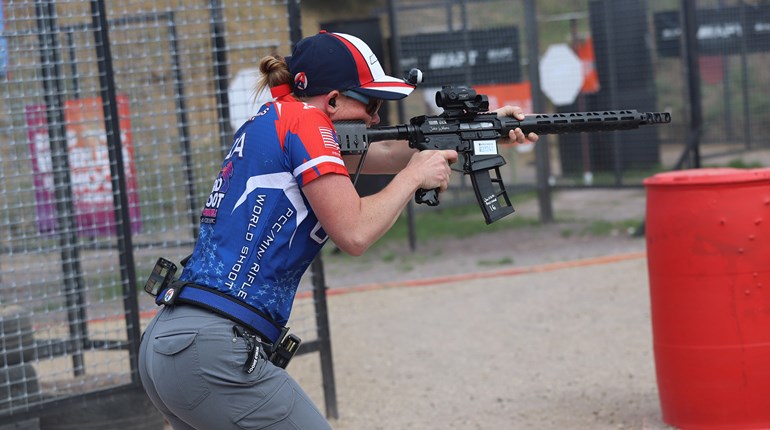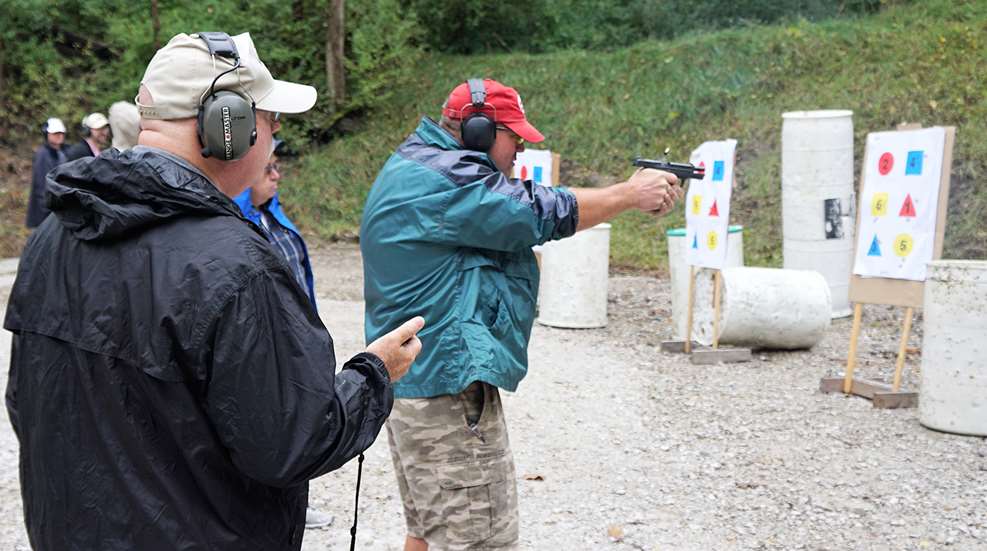
It was late when I arrived at the match hotel, and the parking lot was full. I found a spot around the back of the hotel, grabbed my luggage and range bag and proceeded to the entrance. While walking to the front desk, I could pick out my follow competitors vehicles with the obvious stickers adorned to them.
All checked in, and up in my room, I go over my gear, guns, and ammo. I loaded up the twelve 20-round magazines, checked both my main limited division handgun and the identical backup for it, add some oil and put everything back in the range bag. Since I didn’t get a chance to check in at the range and walk stages, I would hit it very early in the morning.
It was still dark as I made my way to my vehicle with my range bag in hand. As I went out the door into the back parking lot, I noticed two individuals trying to break into someone’s car; scanning the lot, I could see that they had already hit a few cars, including mine. As I stood there, feeling the weight of my range bag pulling on my right arm, the pair noticed me, and the range bag; their attention was now focused on me.
Are You Ready?
No, this is not a stage description from a match, nor did it happen to me. However, this was something that went through my head as I was sitting in Tom Given’s two-day pistol course. I had a chance to attend a one-day shotgun class followed by the two-day pistol course recently. I grew up around shooting, bought my first gun when I was 21 and started shooting competitions almost 20 years ago. I have taken classes from some of the best competition instructors. I am a Master Class shooter in USPSA, so I should be good to go with a gun if I need to defend myself, my home or my family, right?
After almost 28 hours of training with shotgun and pistol, I can most definitely tell you that I am nowhere near as prepared as I thought I would be. It’s not because I don’t know how to use a gun―I do, and not just some custom-built race guns. I know that I should have a much better chance than the guy who bought a gun, a box of ammo and fired it 15 times then started to carry it, but I am that much better off?
Tom Givens is a former law enforcement officer from Memphis, TN, who has been involved with training for more than 40 years. Givens spent 25 years in law enforcement and specialized security work; during that time he made hundreds of arrests, including numerous armed felons. He has been in situations where he has used a handgun to defend himself and others against armed criminals. In those 40 years, Givens has trained security officers and law enforcement officers at all levels, including Federal and foreign government agents. Tom is also no stranger to competition shooting; he was an IPSC Section Champion in the late 1970s and has won several State IDPA Championships. He had also served on the Board of IDPA and was match director for the Winter Nationals that was held at RangeMasters in Memphis when Givens owned the indoor range.
Learning Something New
The start of each class was an overview of what we would cover and why we were going to cover it. Tom does not sugarcoat that we live in a world with evil people in it. As he works through the classroom part, he explains the safety protocols that we are going to follow and why. Givens includes several statistics on just how dangerous a world we live in; going over several things he has been witness to as well. Of all the students Tom has taught, there have been 66 who have had to defend themselves; 63 of the 66 came out of it to talk about it. The three who didn’t, unfortunately, were not armed at the time it was their turn to solve the problem.
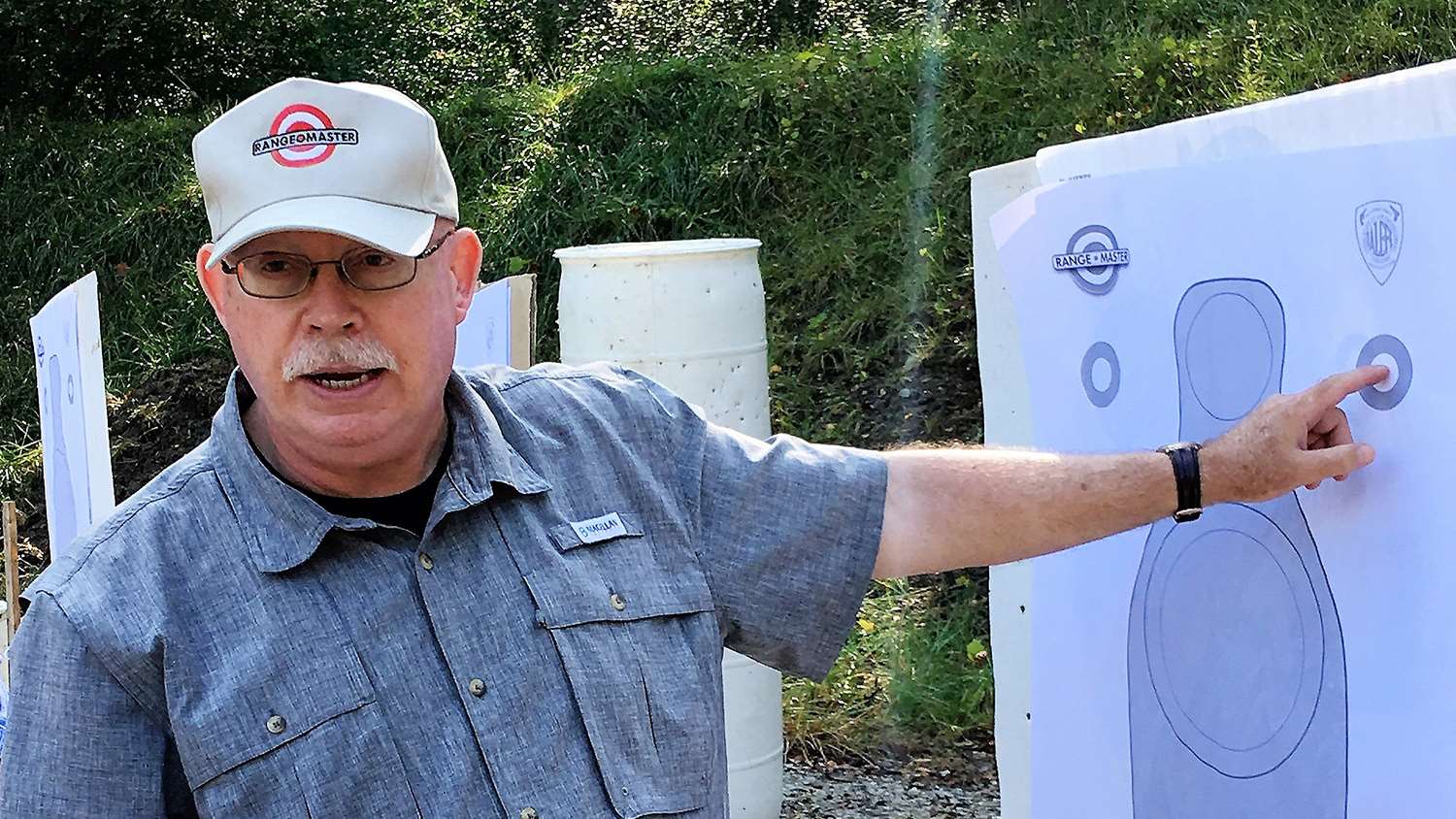
We discussed the four rules of safe gun handling. Tom goes further to break it down into the simplest of terms that should be followed. “It is a gun, so it is loaded; Do not touch the trigger unless you want to shoot; Always know where your muzzle is pointed.”
Givens explained that if you followed these rules, then there should never be an accident. The causes of accidents are ignorance and carelessness. “Once you decide that you should carry a firearm, then you need to understand what accountability versus responsibility means. With the power of being able to take a person’s life, you are going to be held responsible. You are going to be accountable for every round you fire. There are no misses, just unintended hits. Simply put, every round better count.”
As the classroom part continued, we discussed the Defensive Shooting Technique that we would be covering. As defined during the class, a proper defensive shooting technique is a “standardized system of training and operation designed to produce rapid, accurate and decisive hits under stressful conditions.” Does that sound familiar to anyone?
Friday was spent on the use of a shotgun for defense. We delved into a brief history of the shotgun and its use in law enforcement and military, and how it was developed from sporting guns. “The main advantage with a shotgun as a defensive firearm is its unmatched destructive capability at close range. With the right ammunition, there is no such thing as a minor wound up close with a shotgun,” Givens explained. He was very descriptive when he said: “If you have to shoot someone with a shotgun, they stay shot, you cannot sew up a hamburger.”
We spent some time going over the features of both a pump and an auto and discussed different accessories for on-the-firearm ammo carriers as well as various types of sights. You need to decide what will work for you with regards to sidesaddle or a butt carrier. Buy quality, and make the attachment simple. A sidesaddle that has screws holding it in place can and will break. We saw this in class with a fellow student. Super glue and hook and loop attachments to fasten a synthetic ammo carrier in place works well, as demonstrated by Givens.
We hit the range and spent the next several hours working on drills and getting familiar with our chosen shotgun. We started doing dry fire and worked through several exercises this way before moving on to loading with birdshot. We only used the birdshot for the drills to work through multiple shots on target and reloading. Once we were getting more comfortable, we switched to buckshot. Before we started working the drills with buckshot, Givens showed us the differences between what birdshot and buckshot look like on paper and how ineffective birdshot can be on a violent attacker.
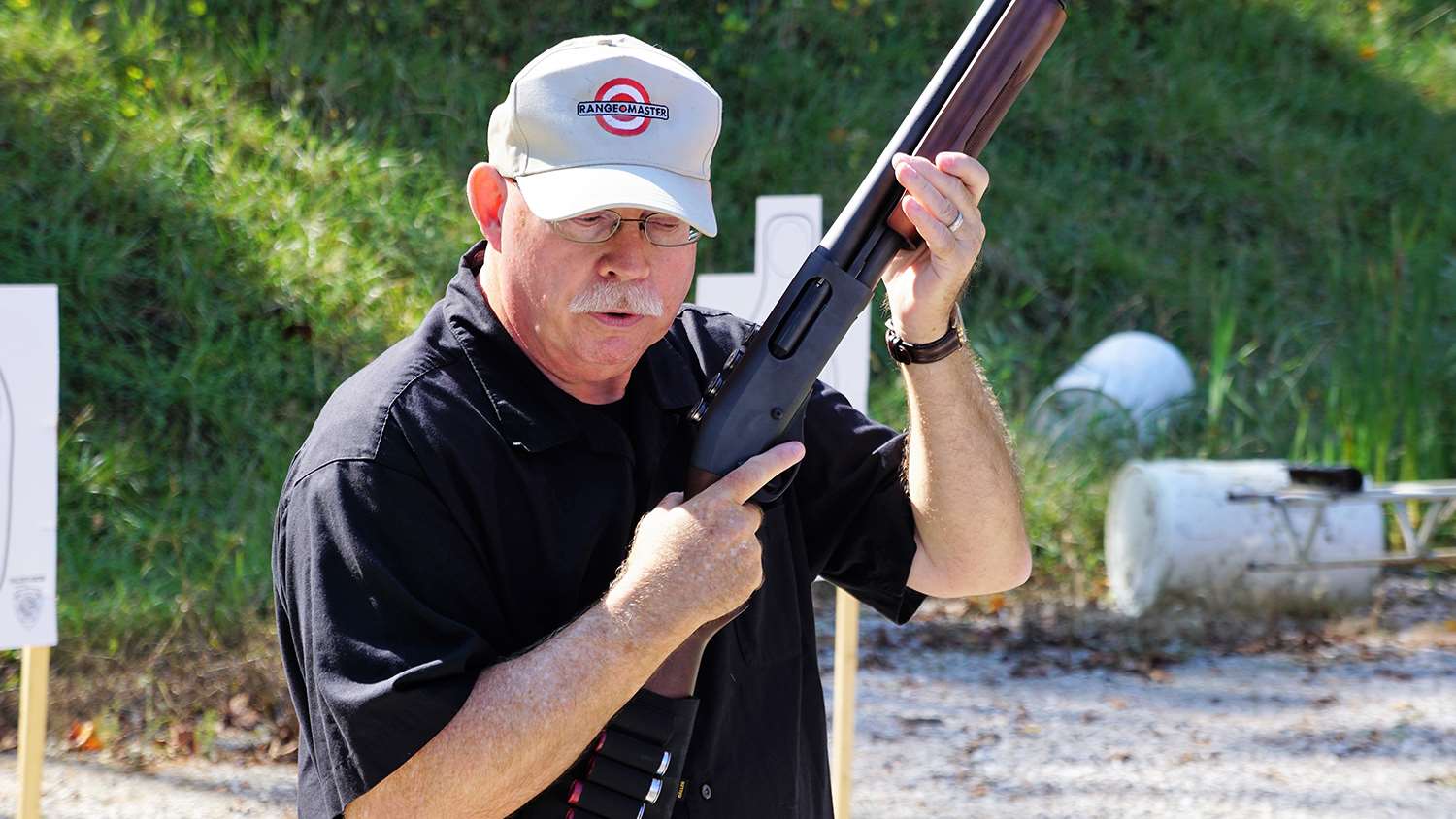
We loaded up the buckshot we brought to class and patterned it on paper to see how effective it could be out of our guns. Shotgun barrels can vary significantly in their performance, and the quality of buckshot can differ as well. A bad combination of cheap buckshot and an out-spec barrel can lead to a very ineffective pattern of buckshot. Know your shotgun and the ammo you are using. Everyone that was using Federal Flight Control eight- or nine-shot buckshot had what would be a very effective way to end a violent attack.
We ended with some classroom discussion that covered the needed maintenance for a shotgun and included making sure that we were checking our defensive ammo on a regular basis. I enjoyed the class, learned a lot about what worked for me and what didn’t. I also learned that just because I have a Remington 870 at the ready to defend my home, I need to reevaluate how I have it set up and the ammo I have selected. Just pointing a shotgun down the hallway and racking it is not going to solve your problem; you had better know how to use it.
Bring on the Handguns
Day two found a new group of students that were here for the two-day pistol class. After being humbled by finding out that I had a lot to learn with a shotgun, I was looking to redeem myself and show that I can run a pistol. After going over the Safe Gun Handling and what we would be working on over the next two days, I was eager to hit the range.
The first day of class I decided to “cheat” a little and run a Walther Q5 out of a Red Hill Tactical Kydex holster, my Production Division set up, just minus the drop offset hanger. Before the class, I had to run by Cabela’s to buy a double mag pouch since everything I had was mounted to my competition outer belts and were not ideal for carrying.
We again started doing dry fire drills with our handguns. We spent a lot of time working on draws from concealment, focusing on making sure that we were getting a good grip on the gun and clearing our cover garment. Some in the class wore a vest or some type of outer garment, while others like myself were drawing from under a shirt. We covered how to draw from both. During the dry fire drills, we spent time on learning the trigger pull of our firearm and the reset of the trigger. We paired off and had our partner place a dime on our front sight as we worked on manipulating the trigger without moving the sights.
We moved to live fire drills and worked on everything from one shot on target from low ready to draws and multiple shots on target. We engaged targets from three to seven yards and went for hits in the eight-inch center mass, the six-inch head area or the three-inch circle on the target. As we did these different engagements, we also had to perform reloads when needed, also from concealment.
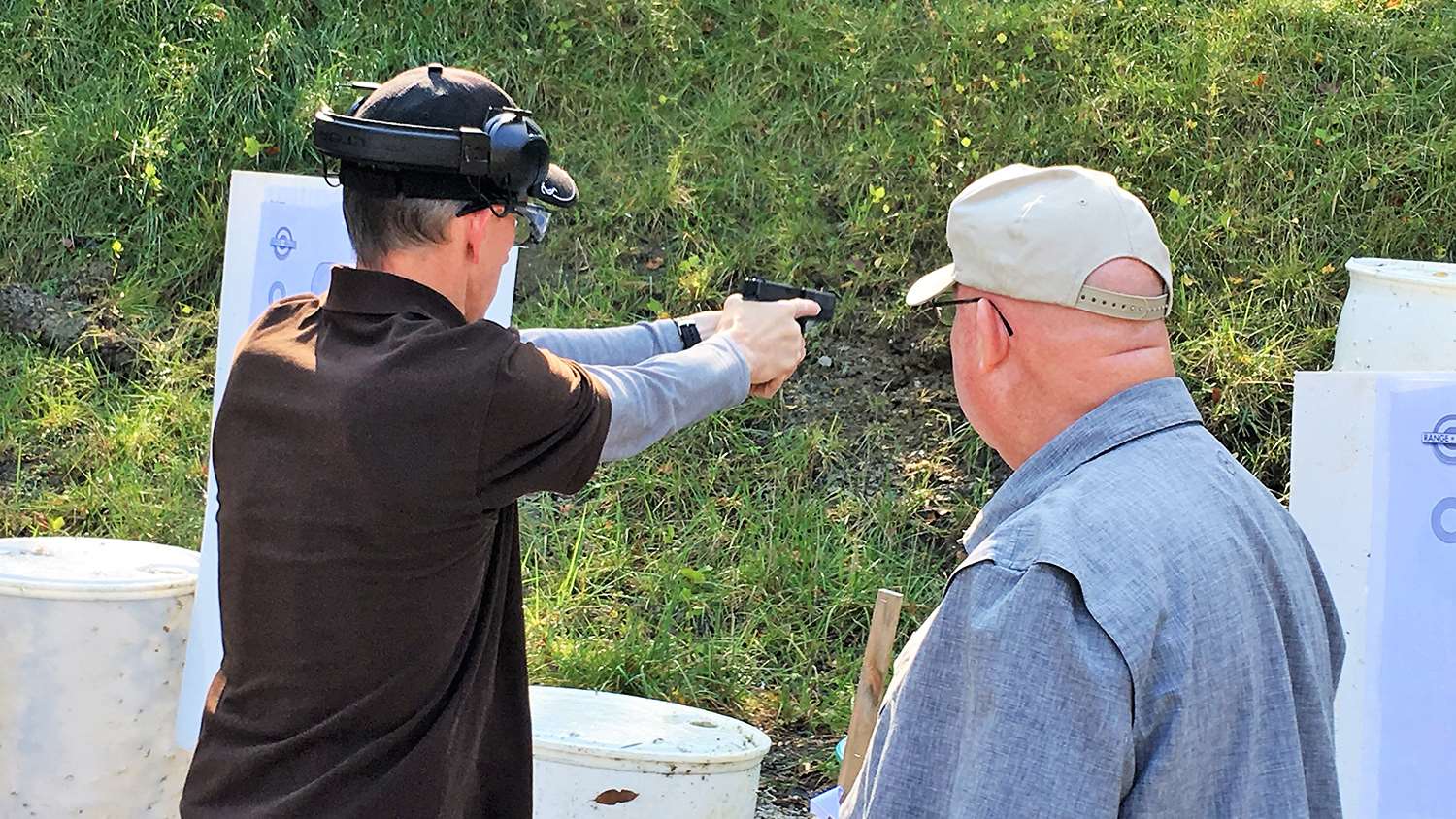
The idea behind using these different sizes was to teach us to see what we needed to see on the sights to make an accurate hit. We were going from a flash sight picture on the center mass to a more precise sight picture to get our hits in the three-inch circle, very similar to how we use our sights in competition.
As we worked through the drills, Tom would have us engage them with different amounts of hits. Sometimes it was two center mass, one head and two in the smaller circle, or any of many other combinations; sometimes we would reverse the order and start on the smallest target first. Most of the engagement was from drawing our firearms; sometimes it was from low ready. Each time we would do something a few times, then change it up so that we would not get comfortable with the shooting part. In competition drills, we will continue to do the same thing over and over again, pushing to see how fast we can accomplish it, very similar to what we were doing with these drills; however, as soon as we got into a rhythm or a pattern, Givens would have us change it up. In a self-defense situation, your best time isn’t going to be your fourth or fifth run―it has to be your first, and you never know what you are going to come face to face with.
We worked on strong and weak hand only drills towards the end of the first day. Tom explained that in many cases when rounds were exchanged, many times individuals were shot in the hands, arms or shoulder areas, causing a person not to be able to have both hands on the firearm. When drawing into strong hand, I would pull my support hand into a fist and hold it on my chest as we competition shooters tend to do during a course of fire. Tom gave me a little “A-ha!” moment; he said that if I was able to pull my support hand to my chest, why wouldn’t I just grip the gun with both hands? I told him because I would get a procedural for each shot fired. Yeah, we had a pretty good laugh on that.
At the end of day one, we did an exercise that would grade us on what we had worked on, a series of drills that covered everything from that day’s class; then Tom scored our targets. There were a possible 150 points on the exercise, and you were down one point for each shot outside the target area. I went 147 out of 150. I tried to call for an overlay on a hit that was clearly on the line; Givens gave me a smug look and said: “Hits only count in the target area.”
I have shot the Walther Q5 quite a bit, including at the Arkansas Section Match and Area 5 Steel Challenge. During the class, I managed to ride the slide release and lock the slide back at least four times, something that I had not done before. Lesson learned―know your carry gun, shoot it, learn what works for you, and what you need to adjust.
When I arrived at the range for the second day of the pistol class, it looked very much like we were going to be up against some rainy weather. We spent some time in the classroom to go over what we had covered the day before, and answer any questions that anyone had from the previous day’s work. Tom went over the classroom scores from the exercises we did the previous day. During his explanation of the results as a class, he was very matter-of-fact. “If you are going to a training class and they are not testing what you have learned then you are wasting your money.”
I had decided that morning before leaving the house that I would switch to my actual carry setup, a Walther PPQ M2 four-inch out of an inside-the-waistband holster from Clinger, the No Print Wonder. I had started to use this as my carry gun because I wanted the higher capacity that the Walther offers over the S&W Shield that I had been carrying, and it was essentially the same gun as the Q5, just with a shorter barrel. I only had a few hundred rounds through this particular handgun.
The weather cleared up, so we hit the range and did a quick review of things covered the previous day. We were going to move on to new drills that would induce a much higher level of stress and require a lot more thinking. We swapped out the targets that we had used to ones that now had three different shapes, three different colors and were numbered one through six. We used this style of target the remainder of the class and ran a series of drills that would continue to push each student. We started with Tom calling out a number; whatever number was called out was the number of the target that we would engage, with that same number of rounds. If he yelled out, “four”, we would draw and put four rounds into the shape with the number four in it. If he yelled out a color, we would engage the smaller number of that color first, then the next number. We did this several different ways and included forced reloads as we went.
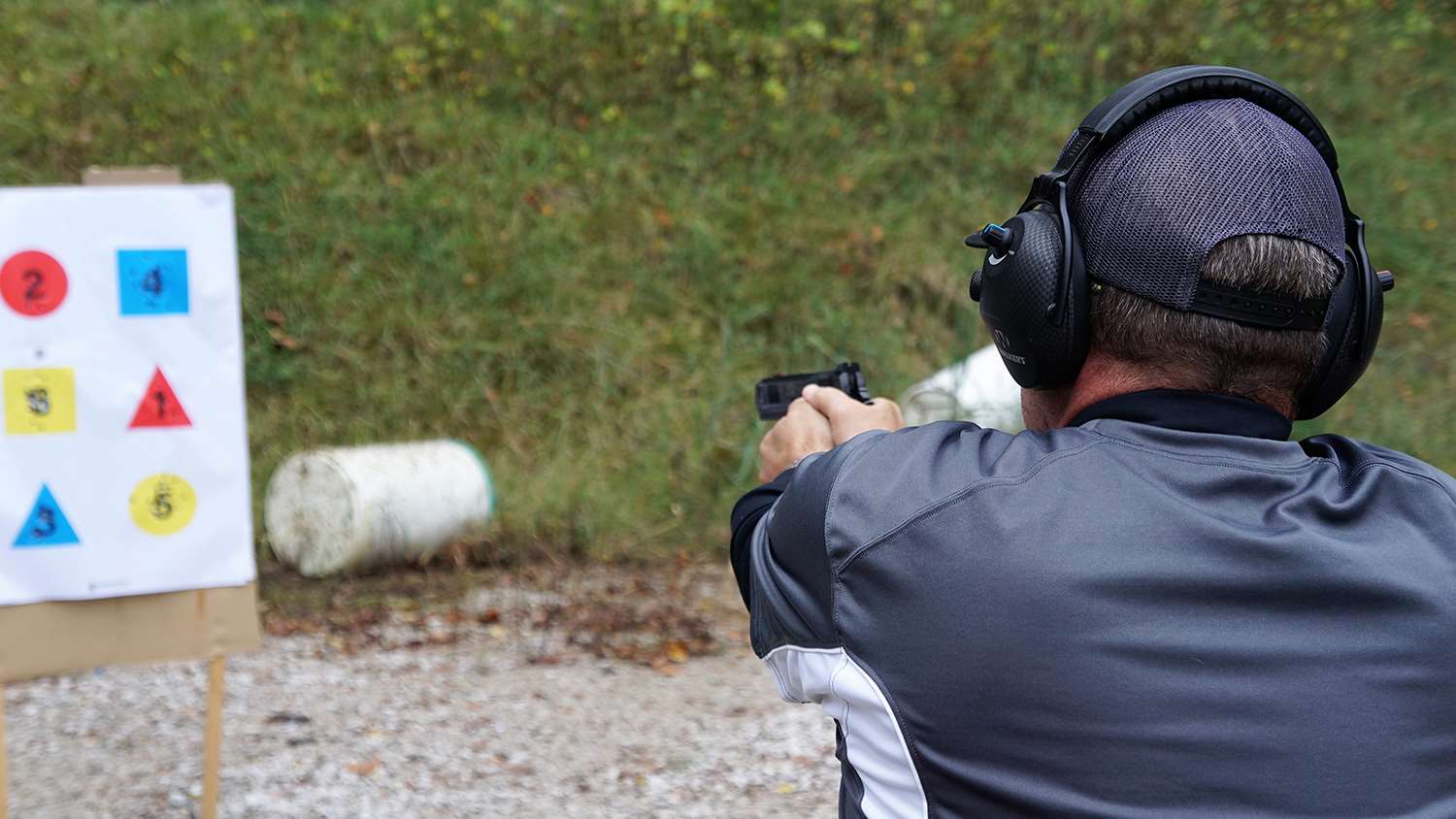
As we got comfortable with these drills and our brain became used to the numbers, colors, and patterns, it was time to change it up again. This time we had the stress of doing it on the clock, and reduced the rounds in our magazines to force reloads at uncertain times during the drills. The time given to complete the exercises was enough to get your hits, especially at the distance we were working from, but as soon as we added the stress of time and the uncertain reload if needed, our shots started to miss those shapes on the target. We divided into groups and ran different drills several times against the opposing group to see who the last man standing was. It added some fun, but again, it was designed to add stress and push us to see what we could accomplish. During the drills, I began to inadvertently bump the magazine release and either dump the magazine or have to tap and rack to complete the drill. Another lesson learned that through regular use of my chosen carry gun I would have discovered this.
Our next test was the Casino Drill, Three Sevens. The object of this drill is that you start with a magazine with seven rounds in it and have two additional magazines loaded to seven only. On the command, we had to draw and engage the targets in numerical order with the corresponding number of rounds (target one got one round, target two would get two rounds and so on). We were given plenty of time to complete this, 20 seconds for the 21 rounds required, but all your rounds had to stay in the shape of that corresponding number. The trick here is that you had to go in order, and would go to slide lock and have to perform a reload. This would require you to remember where you were in the numerical sequence to engage the target after your reload. We ran this few times as a group, then Givens had each of us run this one at a time while the rest of the class watched. I ran it in 16.48 with one round outside of the target for one added second, for the fastest time in the class at 17.48. I was pleased that I didn’t dump my magazine during this drill.
Tom discussed the benefits of this drill, stressing the importance of testing oneself in these types of drills. We split up to work on failure drills for the remainder of the range portion. Pairing up, we had our partner place a spent piece of brass in the “stovepipe” position and worked through clearing this with the tap-and-rack drill. After dumping my magazine several times in the other drills, I thought that this would be no issue for me, but twice during the drill I managed not to get the gun cleared. I managed to lock it up worse with causing a double feed, demonstrating my inexperience with my carry gun. I am used to doing unloaded starts in competition by racking the slide with the front cocking serrations; this did not work well in trying to clear the spent case and get the gun back into action. I was not racking the slide far enough to the rear to pull the loaded round out while trying to clear the spent case, causing the double feed locking up the gun. Again, I found out that I was not as prepared as I thought. Just because I very familiar with handguns and can run stages at matches doesn’t necessarily mean that I good to go if the need arises to defend myself.
This article is not intended to debate the tactical world versus the competition world. Neither was Givens’ class. There were times when Tom discussed competition and its benefits; there were times that he said what we were doing in the training class wasn’t for competition and what we do in competition wasn’t for self-defense, but he never discouraged anyone from trying either. He did not discuss handgun preferences in any depth; instead, he stressed getting a good quality firearm, something with high capacity magazines, good ammo and learning how to use it.
On match day we may feel like John Wick as we make our way through a course of fire. We may even have the ideal carry gun, holster and premium self-defense ammo selected. We may have our shotguns and other self-defense firearms at the ready around our home to defend it. But are you ready to use them when it is your turn to solve the problem?
For more information on Tom Givens and his classes please go to rangemaster.com
About the author
As USPSA Director of Media and Events, Jake Martens has been involved in competitive shooting for over 17 years starting with local IDPA matches. He has participated in USPSA matches since 2004 and served as Section Coordinator and Match Director for numerous matches. He holds Master Class in USPSA and has competed all over the country in state, region and national matches including MultiGun and World Speed Shooting Championships. Jake resides in Indianapolis, IN, with his wife and children and works full time for USPSA handling all aspects of media, editor of FrontSight magazine, affiliated Club Coordinator and Nationals Sponsor Coordinator.













